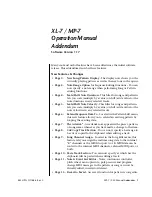
3
saline. An 18G spinal needle is then used to
open the dura in a cruciate fashion. The stylet
can be inserted to ensure adequate opening of
the dura.
Following opening of the dura, the Camino
Bolt is screwed manually into the skull. The
seating depth of the Camino Bolt will be at the
surgeon’s discretion pending the thickness of
the skull. This will be approximately 2–3 mm
for the neonatal age group, 3–5 mm for the
pediatric age group and 5 mm to 1 cm for
adults. If desired, the spacer can be used as
a guide, otherwise the spacer can be removed
and discarded.
The stylet provided in the kit is inserted through
the Camino Bolt and the dura to clear the
passage for the Camino Transducer-Tipped
Catheter.
The Camino Bolt is irrigated with non-
bacteriostatic sterile saline.
CAMINO PRESSURE-
TEMPERATURE MONITORING
CATHETER PREPARATION PRIOR
TO INSERTION
The Camino catheter is used with the
Camino intracranial pressure monitor (models
V420/420, MPM, CAM01, or CAM02). For
Camino monitor set-up and use, refer to the
appropriate Camino monitor Instructions for
Use.
Remove the Camino Catheter from its sterile
package and firmly attach the transducer
connector to the preamp connector (Figure 2).
If the Camino display does not read zero after
a short system self-check delay, use the tool
from the catheter kit to turn the zero adjustment
on the bottom side of the transducer connector
until the Camino display reads zero (Figure 3).
Remove cover from the thermistor connector
of the Camino Catheter. To interface with
host monitor cardiac output module, connect
cardiac output monitor cable connector to
Camino Thermistor Connector. Verify that a
temperature is displayed on the Host Monitor.
INSERTION OF CAMINO CATHETER
To measure intracranial pressure and
temperature, insert the Camino Catheter into
the Camino Bolt, using the cm markings on the
catheter to gauge insertion depth (Figure 4).
The thermistor is placed approximately 1 cm
from the tip of the catheter. If the surgeon places
his fingers between the 6 and 7 cm marks
(double dot at the 5 cm mark), then inserts the
catheter until his fingers touch the top of the
bolt, the tip of the catheter will be 2 cm beyond
the end of the bolt, into the parenchyma. He
should pull the catheter back slightly, then
turn the compression cap on the Camino Bolt
clockwise to secure the catheter in place. If
using a Host Monitor and/or Camino monitor,
verify pressure waveform. If necessary, loosen
the compression cap, reposition the Camino
Catheter, and retighten the compression cap.
IF LOOSENING IS REQUIRED, TAKE CARE
TO ENSURE NO COMPONENT OR PART
OF THE CAMINO CATHETER MOVES OR
FALLS OUT DURING LOOSENING. FAILURE
TO DO SO MAY RESULT IN AN INABILITY
TO SECURE THE CATHETER.
While holding the catheter from above, slide
the strain relief sheath down and secure it onto
the compression cap.
WHEN THE RED DEPTH INDICATOR IS
VISIBLE ABOVE THE STRAIN RELIEF,
THERMISTOR IS NOT EXPOSED
TO TISSUE AND AN INACCURATE
TEMPERATURE READING MAY RESULT.
CHECK THERMISTOR POSITION TO
ENSURE DESIRED DEPTH INTO TISSUE IS
ACHIEVED.
Figure 2
Figure 3
Figure 4
TRANSDUCER
CONNECTOR
TRANSDUCER
CONNECTOR
PREAMP
CONNECTOR
PREAMP
CONNECTOR
ZERO
ADJUSTMENT
TOOL
1 cm MARKINGS
COMPRESSION
CAP
5 cm
Содержание Camino 110-4BT
Страница 2: ...This page intentionally left blank...
Страница 39: ...37 Deze pagina opzettelijk blanco gelaten...






































